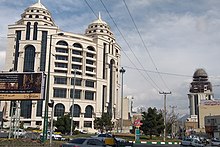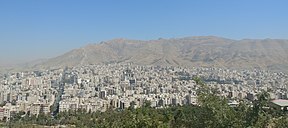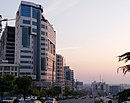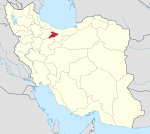Karaj
Karaj
کرج | |
|---|---|
City | |
Panoramic, Soleymaniyeh Palace, Taleghani Boulevard, Pearl Palace, Tulips Festival, Amir Kabir dam lake, Zana Aderan Village | |
| Coordinates: 35°49′38″N 50°56′56″E / 35.82722°N 50.94889°E[1] | |
| Country | Iran |
| Province | Alborz |
| County | Karaj |
| District | Central |
| Government | |
| • Mayor | Mehrdad Kiani |
| • City Council Chairman | Javad Chapardar |
| Area | |
• City | 162 km2 (63 sq mi) |
| Elevation | 1,312 m (4,304 ft) |
| Population (2016)[3] | |
• City | 1,592,492 |
| • Density | 9,800/km2 (25,000/sq mi) |
| • Urban | 1,973,470 |
| • Metro | 2,512,737[2] |
| • Population Rank in Iran | 4th |
| Time zone | UTC+3:30 (IRST) |
| Area code | 026 |
| Climate | BSk |
| Website | karaj.ir |
Karaj (Persian: کرج; pronounced [kæˈɾædʒ] ⓘ)[a] is a city in the Central District of Karaj County, Alborz province, Iran, serving as capital of the province,[5] the county, and the district.[6] Earliest evidence of inhabitation in Karaj can be dated to the Bronze Age at Tepe Khurvin.[7][8] The city was developed under the rule of the Safavid and Qajar Empire and is home to historical buildings and memorials from those eras. This city has a unique climate due to access to natural resources such as many trees, rivers, and green plains. After Tehran, Karaj is the largest immigrant-friendly city in Iran, so it has been nicknamed "Little Iran."[citation needed]
Although the county hosts a population around 1.97 million, as recorded in the 2016 census,[3] most of the 1,419 km2 (548 sq mi) county is rugged mountain. The urban area is the fourth-largest in Iran, after Tehran, Mashhad, and Isfahan.[9] Eshtehard County[10] and Fardis County[11] were split off from Karaj County since the previous census.
History
[edit]
The area around Karaj has been inhabited for thousands of years, as shown by the Bronze Age site of Tepe Khurvin and the Iron Age site of Kalak.[12][13] However, the present-day city of Karaj is mostly the result of modern industrial development in the 20th century.[13]
Karaj was mostly significant as a stage on the road between Tehran and Qazvin.[13] In Safavid times, a stone bridge was built that served as the main crossing into the town.[13] The large Shah-Abbasi Caravansarai, located at the southeast of Towhid Square, was built in the same era, under the rule of Šāh Esmāil.
In 1810, the Qajar prince Soleyman Mirza built the Soleymaniyeh Palace at Karaj to serve as a summer resort.[13] The palace had four towers and was surrounded by gardens, and its reception room featured a pair of paintings by Abdallah Khan Naqqashbandi.[13] By 1860, however, the palace was described as abandoned and only used as a shelter for travelers.[13] Naser al-Din Shah Qajar later renovated the palace.[13] In 1917, a School of Farming was established on the site, replacing the earlier Mozaffari Agricultural School in Tehran.[13] Later, Reza Pahlavi granted it to the University of Tehran's new Faculty of Agriculture.[13]
In the 1930s, plans were drawn up for a large industrial complex covering 216 hectares on the south side of the village.[13] This "Industrial Model Town of Karaj" was intended to be the site of the country's first steel mills, capitalizing on easy access to water and coal from the Alborz.[13] However, the construction equipment imported from Germany was impounded by the British going through the Suez Canal in 1940, and the planned complex was never built.[13]
A major industrial complex, the first privately-owned one in Karaj, was built in the 1960s by Mohammad-Sadeq Fateh.[13] This complex, called Shahrak-e Jahanshahr, included oil, tea, and textile factories as well as housing for the workers.[13]

The Morvārid Palace was constructed in nearby Mehršahr district, during the Pahlavi era. It was designed by the Frank Lloyd Wright Foundation (Taliesin Associated Architects) on instructions from Shams Pahlavi, elder sister of Mohammad Reza Pahlavi. In this period it was a transit and industrial town.
Majority of the structure is now controlled by the Basij Organization, and some sections of it are open to public under the operation of Cultural Heritage Organization of Iran.
Other historical sites of the city include the Mausoleum of Šāhzāde Soleymān, Emāmzāde Rahmān, Emāmzāde Zeyd, and Palang Ābād e Eštehārd.[14]
Demographics
[edit]Ethnicity
[edit]The majority of the residents of Karaj are Persians, with Azerbaijanis making up the second major ethno-linguistic group of the city. Kurds, Gilak, Tabari and Lurs include the other ethnicities among the population of Karaj.
| Male | Female | Total | Ref. |
|---|---|---|---|
| 890,824 | 886,570 | 1,759,394 | [16] |
| age (0–14 years) | age (15–29 years) | age (30–64 years) | age (65 years and older) |
|---|---|---|---|
| 20.3% | 23.6% | 50.2% | 6.0% |
Population
[edit]At the time of the 2006 National Census, the city's population was 1,377,450 in 385,955 households, when it was in Tehran province.[17] The 2016 census measured the population of the city as 1,592,492 people in 508,420 households,[3] by which time the county had been separated from the province in the establishment of Alborz province.[5]
Geography
[edit]Regions
[edit]
The downtown of Karaj is usually referred to Karaj Square, located hundred of meters to the west of Karaj River and the old Karaj Bridge. The villages Hesārak, Gowhar Dašt, and Šahrak e Azimie are located in the northern Greater Karaj.
Meškin Dašt, a large agricultural area between Mehršahr and Fardis, is near Karaj.
The following table includes the major districts of the city:
| Gouhar Daŝt | Mehrŝahr | Kiānmehr | Karaj e Now | Hesārak | Deraxti | Azimie | Ouj | Ŝāhin Villā | Bonyād | Bāqestān | Doulat Ābād |
| Garm Darre | Ŝahrake Jahānŝahr | Mesbāh | Mehr Villā | Dehqān Villā | Māhdaŝt | Ŝahrake Banafŝe | Fardis | Vahdat | Kalāk o Hesār | Estām Ābād | Golŝahr |
| Golŝahr Villā | Zibā Daŝt | Zoube Āhan | Sāsāni | Homāyun Villā | Mehrānŝahr | Mehdi Ābād | Ŝahrake Xātam | Miān Jādde | Heydar Ābād | Sāwoj Bolāq | Bahārestān |
Open space recreational areas of Karaj include Irānzamin Park, Pārk e Xānvāde, Tennis Park, Pārk e Mādar, Tāleqān Gardens, Kordān Gardens, Jahānšahr Gardens, Pardis e Golhā, and the Tulip Garden of Gačsār.
Climate
[edit]The climate of Karaj is a bit cooler than Tehran's, and it receives 250 mm of rain annually (and like Tehran, the precipitation pattern is similar to those of Mediterranean climates). The Köppen-Geiger climate classification system classifies the city's climate as cold semi-arid (BSk).[18]
| Climate data for Karaj (1985–2010) | |||||||||||||
|---|---|---|---|---|---|---|---|---|---|---|---|---|---|
| Month | Jan | Feb | Mar | Apr | May | Jun | Jul | Aug | Sep | Oct | Nov | Dec | Year |
| Record high °C (°F) | 18.2 (64.8) |
19.8 (67.6) |
27.4 (81.3) |
33.0 (91.4) |
34.6 (94.3) |
39.2 (102.6) |
42.0 (107.6) |
40.2 (104.4) |
37.2 (99.0) |
31.8 (89.2) |
25.0 (77.0) |
20.0 (68.0) |
42.0 (107.6) |
| Mean daily maximum °C (°F) | 6.1 (43.0) |
9.0 (48.2) |
14.2 (57.6) |
20.7 (69.3) |
26.2 (79.2) |
32.6 (90.7) |
35.2 (95.4) |
34.5 (94.1) |
30.4 (86.7) |
23.5 (74.3) |
15.1 (59.2) |
8.9 (48.0) |
21.4 (70.5) |
| Daily mean °C (°F) | 1.8 (35.2) |
4.1 (39.4) |
8.7 (47.7) |
14.5 (58.1) |
19.2 (66.6) |
24.6 (76.3) |
27.1 (80.8) |
26.8 (80.2) |
22.9 (73.2) |
17.1 (62.8) |
9.9 (49.8) |
4.6 (40.3) |
15.1 (59.2) |
| Mean daily minimum °C (°F) | −2.5 (27.5) |
−0.7 (30.7) |
3.2 (37.8) |
8.4 (47.1) |
12.2 (54.0) |
16.5 (61.7) |
19.0 (66.2) |
19.1 (66.4) |
15.3 (59.5) |
10.8 (51.4) |
4.8 (40.6) |
0.3 (32.5) |
8.9 (48.0) |
| Record low °C (°F) | −19.0 (−2.2) |
−15.6 (3.9) |
−10.5 (13.1) |
−3.5 (25.7) |
−0.4 (31.3) |
7.2 (45.0) |
10.6 (51.1) |
12.0 (53.6) |
7.0 (44.6) |
−0.5 (31.1) |
−6.0 (21.2) |
−14.6 (5.7) |
−19.0 (−2.2) |
| Average precipitation mm (inches) | 30.8 (1.21) |
32.1 (1.26) |
45.4 (1.79) |
39.1 (1.54) |
19.5 (0.77) |
2.7 (0.11) |
3.0 (0.12) |
1.2 (0.05) |
1.6 (0.06) |
15.1 (0.59) |
27.7 (1.09) |
33.5 (1.32) |
251.7 (9.91) |
| Average precipitation days (≥ 1.0 mm) | 6.3 | 5.7 | 6.7 | 5.8 | 3.7 | 1.0 | 0.7 | 0.3 | 0.3 | 3.2 | 4.8 | 5.8 | 44.3 |
| Average snowy days | 5.4 | 3.7 | 1.9 | 0.1 | 0.0 | 0.0 | 0.0 | 0.0 | 0.0 | 0.0 | 0.5 | 2.7 | 14.3 |
| Average relative humidity (%) | 67 | 60 | 53 | 48 | 43 | 34 | 35 | 34 | 36 | 44 | 56 | 66 | 48 |
| Mean monthly sunshine hours | 166.3 | 169.7 | 197.4 | 218.1 | 280.7 | 335.2 | 341.5 | 340.1 | 304.2 | 250.1 | 187.2 | 156.8 | 2,947.3 |
| Source: Iran Meteorological Organization (records),[19] (temperatures),[20] (precipitation),[21] (humidity),[22] (days with precipitation and snow),[23] (sunshine)[24] | |||||||||||||
Amir Kabir Dam and some other small lakes are based in Karaj. The city is a starting point for a drive along road forced north through the Alborz mountain to the Caspian Sea.[25]
Economy
[edit]The economic base of Karaj is its proximity to Tehran. It is due to the transportation of products between Tehran and the Caspian Sea. Chemicals, fertilizers and processed agricultural goods are also produced in the city.
Zowb Āhan, the avenue leading to an industrial plant, is located at the south of Ostandar Square. Zowb e Āhan or Zowb Āhan, literally "steel mill", was a contract between the Pahlavi government and a consortium from Nazi Germany. The establishment of the factory Zowb Āhan e Karaj was halted by the beginning of the Second World War, and it was never launched.
Šahrak-e Jahānšahr was the first modern private industrial and housing complex of Karaj, built in the 1960s. The factories Jahān Čit (textile factory), Rowqan Nabāti e Jahān (oil factory), and Čāy e Jahān (tea factory), were established at the complex. It is one of the largest industrial zones of the nation, with a 20% share of the national GDP.
The special economic zone of Payam, with an area about 3,600 ha (36 km2; 8,900 acres) within the territory of Payam International Airport, was established in Karaj for development of air cargo and postal transportation, cold store, and packing services, as well as perishable and time sensitive exports. It is the only SEZ in the region with the privilege of its own airline.
Women's clothing
[edit]Small and medium women's clothing companies in Karaj produce all kinds of daily clothes and leather boots. Karaj was one of the few Iranian cities in the 2010s that controlled the damage to the environment in the process of producing women's clothing. Karaj women's over-the-knee boots are exported to the whole country and have a significant contribution to the city's economy.[26]
Transport
[edit]
Railway
[edit]Karaj is connected by railway and highways to Tehran 40 km east and Qazvin 100 km northwest, and by commuter rail to the subway system of Tehran.
Metro
[edit]The city is served Karaj Metro with 2 lines and 10 stations. Karaj urban railway organization established on 21 December 2001.[27][28]

| Line | Line Route | Length | Stations |
|---|---|---|---|
| 1 | Germdareh – new city of Mehestan | 43 km (26.7 mi) | 7 |
| 2 | Kamalshahr–Mallard | 27 km (16 mi) | 23 |
| 3 | Karaj–Azimiyeh | 14 km (9 mi) | 12 |
| 4 | Baghestan – Karaj (Payam) Airport | 18 km (11.1 mi) | 19 |
| 5 | Shahid Moazen Boulevard – Mohamadshahr | 12 km (7.5 mi) | 10 |
| 6 | Esteghlal Boulevard – Shahid Soltani Square | 9 km (6 mi) | 8 |
"ARMADURA Z29 HELMET ARMOR Z29" by OSCAR CREATIVO |
97 km (60 mi) | 76 | |
Road
[edit]The highway system of Karaj includes Tehran–Karaj Highway, Karaj Special Road, and the old road of Karaj (Fath Highway). Bākeri Expressway is one of the main north-to-south routes in west Tehran, which is connected to the Tehran–Karaj Highway.[29] Tehran–Karaj Highway is one of the busiest sections in Iran with AADT of 217084.[30] Karaj–Qazvin has an AADT of 79606.
The aerial transport of Karaj is served by the Payam International Airport, which was established in 1990, and was officially opened in 1997.
Bus
[edit]Currently, the total number of buses in Karaj and the suburbs are 1,600 units. More than 80 lines serve citizens.[citation needed]
Preparing Alborz Card[31] can reduce the cost of travel tickets.

Metro
[edit]The Karaj Metro consists of two lines. Line One travels from west to east through the city (from Karaj Station to Golshahr Station). It continues eastward to become Line Five of the Tehran Metro. On its way to Tehran, it stops at Chitgar park and Azadi stadium. The second line of Karaj metro (north to south) is under construction and opened for limited service in February 2023.[32][33]
Air
[edit]Payam International Airport, is an international airport located in Karaj, 40 kilometers (25 mi) from Tehran, in the Alborz Province of Iran. The airport was established in 1990, but was not opened officially until 1997. Payam Aviation Services Co. operates the airport as part of Payam Special Economic Zone. Payam Air previously operated an airmail hub at the airport. Currently, this airport and its special area are used for purposes such as cargo transit, commercial transportation, and goods mail in the development of the country's communication and information technology industries.
Sports
[edit]
Karaj was formerly home of the Persian Gulf Pro League club Saipa for several years, and this club won its first league championship in this city; in 2014 the team relocated to Tehran. Currently the only professional football team in city is Oxin Alborz that play in the Azadegan League. The Home stadium of Oxin Alborz F.C. is Enghelab Stadium that located in Karaj Enghelab sport complex and has a capacity of 15,000 people. The stadium held a match between Iran and Indonesia in June 2009. The stadium also held an international match, on May 1, 2012, where Iran's National Football team played Mozambique.
Saipa volleyball team lost to Kalleh in this stadium in 2011–12 and became the runner-up in the final match of the country's volleyball premier league. Saipa has won the runner-up title of Iran Super League seven times.
One of the international ski resorts of Iran The, Dizin ski resort, is located a few kilometers north-east of the city, in the Alborz. In Dizin, along with skiing facilities, there are tennis courtyards, a slope for skiing on turf, some altitudes for mountain climbing and walking as well as riding and some routes for cycling.[34] Karaj also has an international tennis complex which is used to training and tournaments. Jahanshahr International Tennis Complex is located in Bagh Fateh. This park has eight practice courts and one competition court with a capacity of 1,200 people. It is the only tennis complex in Iran that has covered courts.[citation needed]
Education
[edit]

Educational and research centers of the city include:
- University of Tehran (Agriculture and Natural Resources College)
- Kharazmi University (Karaj Campus)
- Tehran University of Art (Karaj Campus)
- Payame Noor University (Karaj Center)
- Technical and Vocational University (Alborz Province)
- University of Applied Science and Technology (Alborz Province)
- Farhangian University (Alborz Province)
- Alborz University of Medical Sciences
- Islamic Azad University, Karaj Branch
- Razi Vaccine and Serum Research Institute
- Agricultural Research, Education and Extension Organization
- Materials and Energy Research Center
- Standard Research Institute
- Nuclear Science and Technology Research Institute (Center of Agriculture and Nuclear Medicine)
Notable people
[edit]Academia and scholars
[edit]- Saied Reza Ameli (b. 1961), a scholar of communication
Abū Bakr Muḥammad ibn al Ḥasan al-Karajī (Persian: ابو بکر محمد بن الحسن الکرجی; c. 953 – c. 1029) was a 10th-century Persian mathematician and engineer who flourished at Baghdad. He was born in Karaj, a city near Tehran. His three principal surviving works are mathematical: Al-Badi' fi'l-hisab (Wonderful on calculation), Al-Fakhri fi'l-jabr wa'l-muqabala (Glorious on algebra), and Al-Kafi fi'l-hisab (Sufficient on calculation).
Actors
[edit]- Mehran Rajabi (b. 1962), actor
- Mehraneh Mahin Torabi (b. 1957), actress
Politicians and political activists
[edit]- Armita Abbasi (born 2001), protester, arrested and assaulted
- Shadi Amin (b. 1964), political activist, researcher
- Fatemeh Ajorlou (b. 1966), politician
- Mahmoud Bahmani (b. 1947), politician
Writers
[edit]- Hossein Sanapour (b. 1960), writer
- Saeed Kamali Dehghan (b. 1985), journalist
Athletes
[edit]- Ali Kiaei (b. 1987), futsal player
- Milad Farahani (b. 1988), football player
- Afshin Kazemi (b. 1986), futsal player
- Ahmad Sanjari (b. 1960), football coach
- Alireza Heidari (b. 1976), Olympic wrestler
- Mehdi Mahdavi (b. 1984), volleyball player
- Mojtaba Taghavi (b. 1968), football player
- Leila Esfandyari (1970–2011), mountain climber
- Ali Mohammadi (b. 1984), wrestler
- Ebrahim Sadeghi (b. 1979), football player
- Ebrahim Masoudi (b. 1982), futsal player
- Reza Mohammadi (b. 1986), football player
- Amin Manouchehri (b. 1986), football player
- Rouhollah Dadashi (1982–2011), powerlifter
- Mohammad Nosrati (b. 1981), football player
- Farshad Falahatzadeh (b. 1967), football player
- Behnaz Shafiei (b. 1989), racing driver and motorcycle racer
See also
[edit]![]() Media related to Karaj at Wikimedia Commons
Media related to Karaj at Wikimedia Commons
![]() Karaj travel guide from Wikivoyage
Karaj travel guide from Wikivoyage
Notes
[edit]References
[edit]- ^ OpenStreetMap contributors (17 August 2024). "Karaj, Karaj County" (Map). openstreetmap.org (OpenStreetMap) (in Persian). Retrieved 17 August 2024.
- ^ Alborz downloaded document [dead link]
- ^ a b c Census of the Islamic Republic of Iran, 1395 (2016): Alborz Province. amar.org.ir (Report) (in Persian). The Statistical Center of Iran. Archived from the original (Excel) on 28 January 2020. Retrieved 19 December 2022.
- ^ Karaj can be found at GEOnet Names Server, at this link, by opening the Advanced Search box, entering "-3069644" in the "Unique Feature Id" form, and clicking on "Search Database".
- ^ a b Larijani, Ali (2010) [Approved 16 April 1389]. Alborz province establishment law. lamtakam.com (Report) (in Persian). Guardian Council. Notification 412/30588. Archived from the original on 16 December 2023. Retrieved 21 August 2024 – via Lam ta Kam.
- ^ Habibi, Hassan (10 December 2014) [Approved 21 June 1369]. Approval of the organization and chain of citizenship of the elements and units of the national divisions of Tehran province centered on the city of Tehran. rc.majlis.ir (Report) (in Persian). Ministry of Interior, Defense Political Commission of the Government Board. Notification 8416/T133K. Archived from the original on 30 November 2014. Retrieved 16 December 2023 – via Islamic Parliament Research Center.
- ^ Foundation, Encyclopaedia Iranica. "Welcome to Encyclopaedia Iranica". iranicaonline.org. Retrieved 16 December 2024.
- ^ Muscarella, Oscar White (1974). "The Iron Age at Dinkha Tepe, Iran". Metropolitan Museum Journal. 9: 35–90. doi:10.2307/1512656. ISSN 0077-8958. JSTOR 1512656.
- ^ City Population: IRAN: Major Cities
- ^ Rahimi, Mohammad Reza (2012) [Approved 17 March 1391]. Approval letter regarding national divisions in Alborz province. rc.majlis.ir (Report) (in Persian). Ministry of the Interior, Board of Ministers. Notification 50868/T46965H. Archived from the original on 5 February 2013. Retrieved 21 August 2024 – via The Research Center of the Islamic Council of Iran.
- ^ Rahimi, Mohammad Reza (1 July 2013) [Approved 29 March 1392]. Approval letter regarding country divisions in Alborz province. rc.majlis.ir (Report) (in Persian). Ministry of the Interior, Council of Ministers. Notification 84917/T49173H. Archived from the original on 26 July 2013. Retrieved 21 August 2024 – via The Research Center of the Islamic Council of Iran.
- ^ L. van den Berghe, La nécropole de Khūrvīn, Istanbul, Nederlands Historisch-Archaeologisch Instituut in het Nabije Oosten, 1964.
- ^ a b c d e f g h i j k l m n o Hourcade, Bernard. "KARAJ i. Modern City". Encyclopaedia Iranica. Retrieved 15 October 2022.
- ^ www.sirang.com, Sirang Rasaneh. "Karaj city in Alborz province, travel to iran, Visit Iran". itto.org | Iran Tourism & Touring.
- ^ "Pars". Pars. Archived from the original on 17 February 2016. Retrieved 12 February 2016.
- ^ "درگاه ملی آمار". www.amar.org.ir. Archived from the original on 6 September 2019. Retrieved 26 June 2019.
- ^ Census of the Islamic Republic of Iran, 1385 (2006): Tehran Province. amar.org.ir (Report) (in Persian). The Statistical Center of Iran. Archived from the original (Excel) on 20 September 2011. Retrieved 25 September 2022.
- ^ "Climate: Karaj - Climate graph, Temperature graph, Climate table". Climate-Data.org. Retrieved 9 September 2013.
- ^
- "Highest record temperature in Karaj by Month 1985–2010". Iran Meteorological Organization. Archived from the original on April 14, 2015. Retrieved April 7, 2015.
- "Lowest record temperature in Karaj by Month 1985–2010". Iran Meteorological Organization. Archived from the original on April 14, 2015. Retrieved April 7, 2015.
- ^
- "Average Maximum temperature in Karaj by Month 1985–2010". Iran Meteorological Organization. Archived from the original on April 14, 2015. Retrieved April 7, 2015.
- "Average Mean Daily temperature in Karaj by Month 1985–2010". Iran Meteorological Organization. Archived from the original on April 14, 2015. Retrieved April 7, 2015.
- "Average Minimum temperature in Karaj by Month 1985–2010". Iran Meteorological Organization. Archived from the original on April 14, 2015. Retrieved April 7, 2015.
- ^
- "Monthly Total Precipitation in Karaj by Month 1985–2010". Iran Meteorological Organization. Archived from the original on March 30, 2015. Retrieved April 7, 2015.
- ^
- "Average relative humidity in Karaj by Month 1985–2010". Iran Meteorological Organization. Archived from the original on April 14, 2015. Retrieved April 7, 2015.
- ^
- "No. Of days with precipitation equal to or greater than 1 mm in Karaj by Month 1985–2010". Iran Meteorological Organization. Archived from the original on April 14, 2015. Retrieved April 7, 2015.
- "No. of days with snow or sleet in Karaj by Month 1985–2010". Iran Meteorological Organization. Archived from the original on April 14, 2015. Retrieved April 7, 2015.
- ^
- "Monthly total sunshine hours in Karaj by Month 1985–2010". Iran Meteorological Organization. Archived from the original on April 14, 2015. Retrieved April 7, 2015.
- ^ Iran. Ediz. Inglese by Andrew Burke, Mark Elliott, and Kamin Mohammadi, 2004
- ^ Karaj Atlas (اطلس کلانشهر کرج) (in Persian). Tehran, Iran: شهرداری کرج. 2019. p. 22.
- ^ "Karaj Urban Railway History". Archived from the original on 4 March 2016. Retrieved 27 May 2015.
- ^ "Iran Railways Map".
- ^ "Main Bridges on Tehran-Karaj Highway Commissioned". Tehran official web site.
- ^ "تردد بیش از یک میلیون خودرو از آزادراه تهران -کرج". Archived from the original on 12 August 2013.
- ^ "البرزکارت | البرزکارت: کارت بلیت الکترونیکی کرج". alborzcard.ir.
- ^ "Second Karaj metro line opened for limited service". www.railwaygazette.com. Retrieved 30 August 2023.
- ^ "UrbanRail.Net -> Karaj". www.urbanrail.net. Retrieved 30 August 2023.
- ^ "ITTO: Dizin Ski Slope". Archived from the original on 7 March 2012. Retrieved 14 December 2010.











